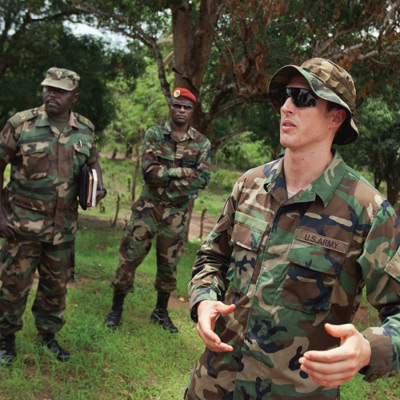
Many former combatants from the Lord’s Resistance Army, or LRA, have given up the fight during the past two years.[i] They have steadily returned to northern Uganda, making long journeys from Sudan, the Central African Republic, or CAR, and the Democratic Republic of the Congo. With the LRA scattered in small groups across a wide swathe of territory, each fighter tells a different story, but nearly all express disillusionment with the LRA and commander Joseph Kony. One fighter who escaped north of Western Bahr el Ghazal state in Sudan said: “Kony lied to us when he said we were fighting for the rights of our people in Uganda. We were too far from home.”
Encouraging the defection of LRA fighters and providing opportunities for them to reintegrate into civilian life are critical components of the wider effort to neutralize the LRA’s threat to civilians and comprise key objectives of President Obama’s strategy to disarm the LRA. Despite the strategic imperative to encourage defections, current efforts are falling short and risk discouraging current fighters from leaving the LRA.
The process of defection brings about countless perils. Men, women, and children formerly in the LRA risk beatings and death if caught by LRA commanders. Once outside of the reach of their commanders, former LRA risk being lynched by the local populations of Congo, Sudan, and CAR as well as being mistreated by the regional armies.[ii]
The majority of former combatants who survive all the hazards associated with abandoning the rebellion are pressured into joining the Ugandan army to fight against the remaining LRA with no training and no salary. Such actions are unethical and potentially illegal. Despite statements lauding the use of former LRA combatants, the practice of pressuring former combatants to fight for the Ugandan army should end.[iii] Pressures range from denying amnesty to outright intimidation. Contrary to commonly held assumptions, the strategic value of former LRA fighters is minimal especially after they are kept for months in Ugandan army bases and “safe houses” in Kampala.[iv] There exists no legitimate reason for the Ugandan army to use former abductees, led by some of the same commanders formerly in the LRA, to do the job of the national army with no training and no pay.[v]
Many of the former fighters able to reach Uganda are reluctant to return to their communities, preferring instead to relocate to major towns in northern Uganda. Fearing retribution from community members they were forced to attack when in the LRA and lacking economic opportunities there, people formerly with the LRA remain “far from home” even when they are physically in Uganda.
This report describes the experiences of former LRA who have recently returned to northern Uganda, explaining their reasons for leaving the LRA ranks, challenges faced throughout the demobilization period, the current status of the remaining LRA groups in Sudan, Congo, CAR, and recommendations to align existing efforts and provide greater incentives to encourage more LRA fighters to defect, disarm and come home.[vi]
[i]This paper is based primarily on interviews with 18 people formerly with the LRA carried out in the months of November and December 2010 and about 60 additional interviews with former LRA combatants in the past 16 months. A dozen interviews with Ugandan army officers and state officials were also conducted.
[ii]Generally speaking, Ugandan soldiers in CAR, Congo and Sudan appear to have treated well former LRA combatants who surrender to them.
[iii]See for instance: “Uganda enlists former rebels to end a war,” New York Times, April 10, 2010, available at http://www.nytimes.com/2010/04/11/world/africa/11lra.html. The article fails to mention that many of the fighters, including the main subject, Opiyo Makasi, were kept in safe houses and forced either by intimidation or lack of other options to join the Ugandan army. There are also questionable statements relating to the effectiveness of former LRA fighters against active LRA fighters.
[iv]Safe houses are in fact places of detention where former LRA are kept and not allowed to leave. Various Ugandan security services, especially one ran by the Chieftaincy of Military Intelligence have been accused of detaining people, and at times torturing them, in the so-called safe houses. See: Human Rights Watch, “Open Secret: Illegal detention and torture by the joint-anti terrorism task force in Uganda,” (2009).
[v]At least three former LRA commanders, Lt. Colonel Opiyo Makasi, Lt. Colonel Charles Arop and Major OkotAtiak currently command separate Ugandan army units of over 200 former LRA fighters in total. Since the former LRA units operate practically independently of the Ugandan army command, this has ensured that the former combatants have been led by the same people both in the LRA and the Ugandan army. “Life is the same,” said a former combatant. “We are still fighting, ordered around by the same people, but this time the enemy is different.”
[vi]It is not the scope of this paper to provide a detailed analysis of reintegration challenges in Northern Uganda; excellent work in this field already exists. See Justice and Reconciliation reports, notably: Justice and Reconciliation, “With or without peace: Disarmament, Demobilization and Reintegration in Northern Uganda,” (2008); and Justice and Reconciliation, “Alice’s story: Cultural and Spiritual Dimensions of Reconciliation in Northern Uganda,” (2006). Also: Tim Allen and Mareike Schomerus, “A Hard Homecoming” (USAID and UNICEF, 2006). An excellent chapter on challenges faced by former combatants especially in relation to land matters can be found in: Gareth McKibben and James Bean, “Land or Else: Land-Based Conflict, Vulnerability and Disintegration in Northern Uganda,” (IOM, UNDP and NRC, 2010).

